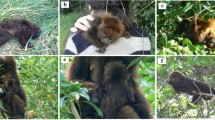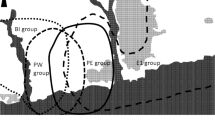Abstract
Infant adoption has been reported in a variety of primate taxa both in captive and natural settings. Adoption by females may be adaptive by increasing inclusive fitness via shared genes between adoptive mother and adoptee or by providing valuable maternal practice which, in turn, may increase the female’s future reproductive success. Others have argued that adoption may be non-adaptive and the result of a general attraction toward infants. Our study examines a unique case of adoption by an adult female Angola black and white colobus monkey (Colobus angolensis palliatus) who adopted an extra-group infant alongside her own biological infant. We compare infant behaviors and mother-infant interactions between biological infant and adoptee and then compare both biological infant and adoptee behavioral profiles to those of infants under normal circumstances. Data were collected from July 2014 to June 2015 on three habituated groups in the Diani Forest of Kenya. Scan sampling and pooled data were used to create daily and monthly behavioral profiles for the biological infant and adoptee, as well as a mean monthly profile of four infants under normal circumstances. Data include time spent (1) clinging to mother/adoptive mother, (2) clinging to another individual, (3) behaving independently, and (4) behaving in close proximity to mother/adoptive mother. Initially, the adoptee struggled to achieve behavioral profiles consistent with those of the biological infant and normal colobus infants of the same age as he spent significantly more time moving independently and significantly less time clinging to the adoptive mother. After the mysterious death of the biological infant in mid-January 2015, the adoptee assumed a behavioral profile similar to that of infants under normal conditions. This case does not support adaptive hypotheses for adoption (i.e., inclusive fitness or learning to mother). Instead, because the biological infant died, possibly due to the presence of the adoptee, we argue that this case of infant adoption was non-adaptive. Ultimately, this adoption appears to have been an outcome of the adoptee’s persistent desire to be cared for and the female’s strong propensity to engage in allomaternal behavior.







Similar content being viewed by others
References
Agoramoorthy G, Rudran R (1992) Adoption in free-ranging red howler monkeys, Alouatta seniculus of Venezuela. Primates 33:551–555
Alley TR (1980) Infantile colouration as an elicitor of caretaking behaviour in Old World primates. Primates 21:416–426
Altmann J, Altmann SA, Hausfater G (1978) Primate infant’s effects on mother’s future reproduction. Science 201:1028–1030
Anderson J, Rowcliffe JM, Cowlishaw G (2007) The Angola black-and-white colobus (Colobus angolensis palliatus) in Kenya: historical range contraction and current conservation status. Am J Primatol 69:664–680
Bădescu I, Sicotte P, Ting N, Wikberg EC (2015) Female parity, maternal kinship, infant age and sex influence natal attraction and infant handling in a wild colobine (Colobus vellerosus). Am J Primatol 77:376–387
Bocian CM (1997) Niche separation of black-and-white colobus (Colobus angolensis and C. guereza) in the Ituri forest. Ph.D.thesis, City University of New York
Boesch C, Bole C, Eckhardt N, Boesch H (2010) Altruism in forest chimpanzees: the case of adoption. PLoS One 5(1):e8901. doi:10.1371/journal.pone.0008901
Brent LJN, Teichroeb JA, Sicotte P (2007) Preliminary assessment of natal attraction and infant handling in wild Colobus vellerosus. Amer J Primatol 69:1–7
Chapman CA, Walker S, Lefebvre L (1990) Reproductive strategies of primates: the influence of body size and diet on litter size. Primates 31:1–13
Dolhinow P (1980) An experimental study of mother loss in the Indian langur monkey (Presbytis entellus). Folia Primatol 33:77–128
Dolhinow P, DeMay MG (1982) Adoption: the importance of infant choice. J Hum Evol 11:391–420
Dunham NT (2015) Ontogeny of positional behavior and support use in Colobus angolensis palliatus of the Diani Forest, Kenya. Primates 56:183–192
Dunham NT, McGraw WS (2014) Positional behavior and habitat use of Peters’ Angola black and white colobus monkey (Colobus angolensis palliatus) in structurally distinct areas of the Diani Forest, Kenya. Afr Primates 9:1–14
Ellsworth JA, Andersen C (1997) Adoption by captive parturient rhesus macaques: biological vs. adopted infants and the cost of being a “twin” and rearing “twins”. Am J Primatol 43:259–264
Fairbanks LA (1990) Reciprocal benefits of allomothering for female vervet monkeys. Anim Behav 40:553–562
Fashing PJ, Mulindahabi F, Gakima J, Masozera M, Mununura I, Plumptre AJ, Nguyen N (2007) Activity and ranging patterns of Colobus angolensis ruwenzorii in Nyungwe Forest, Rwanda: possible costs of large group size. Int J Primatol 28:529–550
Fimbel C, Vedder A, Dierenfeld E, Mulindahabi F (2001) An ecological basis for large group size in Colobus angolensis in the Nyungwe Forest, Rwanda. Afr J Ecol 39:83–92
Gould L (2000) Short communication: adoption of a wild orphaned ringtailed lemur infant by natal group members: adaptive explanations. Primates 41:413–419
Hamilton WJ III, Busse C, Smith KS (1982) Adoption of infant orphan chacma baboons. Anim Behav 30:29–34
Hasegawa T, Hiraiwa M (1980) Social interactions of orphans observed in a free-ranging troop of Japanese macaques. Folia Primatol 33:129–158
Horwich RH, Manski D (1975) Maternal care and infant transfer in two species of Colobus monkeys. Primates 16:49–73
Hrdy SB (1976) Care and exploitation of nonhuman primate infants by conspecifics other than the mother. In: Rosenblatt JS, Hinde RA, Shaw E, Beer C (eds) Advances in the study of behavior, vol 6. Academic Press, New York, pp 101–158
Hrdy SB (1980) The langurs of Abu. Harvard University Press, Cambridge
Izar P, Verderane MP, Vilsaberghi E, Ottoni EB, de Oliveira MG, Shirley J, Fragaszy D (2006) Cross-genus adoption of a marmoset (Callithrix jacchus) by wild capuchin monkeys (Cebus libidinosus): case report. Am J Primatol 68:692–700
Izawa K (1989) The adoption of an infant observed in a wild group of red howler monkeys (Alouatta seniculus). Field Stud New World Monkeys La Macarena Columbia 2:33–36
Kriege PD, Lucas JW (1974) Aunting behavior in an urban troop of Cercopithecus aethiops. J Behav Sci 2:55–61
Lancaster JB (1971) Play-mothering: the relations between juvenile females and young infants among free ranging vervet monkeys (Cercopithecus aethiops). Folia Primatol 15:161–182
Link A, Palma AC, Velez A, de Luna AG (2006) Costs of twins in free-ranging white-bellied spider monkeys (Ateles belzebuth belzebuth) at Tinigua National Park, Colombia. Primates 47:131–139
Lowe AJ, Sturrock GA (1998) Behaviour and diet of Colobus angolensis palliatus Peters 1868, in relation to seasonality in a Tanzanian dry coastal forest. Folia Primatol 69:121–128
Maestripieri D (1994) Social structure, infant handling and mothering styles in group living Old World monkeys. Int J Primatol 15:531–553
Maisels F, Gautier-Hion A, Gautier JP (1994) Diets of two sympatric colobines in Zaire: more evidence on seed-eating in forests on poor soils. Int J Primatol 15:681–701
Matsuda I, Zhang P, Swedell L, Mori U, Tuuga A, Bernard H, Sueur C (2012) Comparisons of intraunit relationships in nonhuman primates living in multilevel social systems. Int J Primatol 33:1038–1053
McKenna JJ (1979) The evolution of allomothering behavior among colobine monkeys: function and opportunism in evolution. Am Anthropol 81:818–840
Metcalfe K, French-Constant R, Gordon I (2009) Sacred sites as hotspots for biodiversity: the three sisters cave complex in coastal Kenya. Oryx 44:118–123
Moreno-Black GS, Maples WR (1977) Differential habitat utilization of four cercopithecidae in a Kenyan Forest. Folia Primatol 27:85–107
Ogawa H (1998) Brief report: Adoption and social interactions between mother and “twin” offspring in Macaca fuscata. Folia Primatol 69:100–105
Pelé M, Petit O (2015) Equal care for own versus adopted infant in tufted capuchins (Sapajus spp.). Primates 56:201–206
Poirier FE (1968) The Nilgiri langur (Presbytis johnii) mother-infant dyad. Primates 9:45–68
Quade D (1967) Rank analysis of covariance. J Am Stat Assoc 62:1187–1200
Quiatt D (1979) Aunts and mothers: adaptive implications of allomaternal behavior of nonhuman primates. Am Anthropol 81:310–319
Riedman ML (1982) The evolution of alloparental care and adoption in mammals and birds. Q Rev Biol 57:405–435
Tardif SD, Power M, Oftedal T, Power RA, Layne DG (2001) Lactation, maternal behavior and infant growth in common marmoset monkeys (Callithrix jacchus): effects of maternal size and litter size. Behav Ecol Sociobiol 51:17–25
Taylor H, Teas J, Richie T, Southwick C, Shrestha R (1978) Social interactions between adult male and infant rhesus monkeys in Nepal. Primates 19:343–351
Thierry B, Anderson J (1986) Adoption in anthropoid primates. Int J Primatol 7:191–215
Waters SS, Thomas D (1996) An observation of adoption in colobus monkeys (Colobus guereza kikuyuensis). ABWAK 23:59
Wikberg EC, Sicotte P, Campos FA, Ting N (2012) Between-group variation in female dispersal, kin composition of groups, and proximity pattern in a black and white colobus monkey (Colobus vellerosus). PLoS One 7:e48740
Winkler P, Loch H, Vogel C (1984) Life history of Hanuman langurs (Presbytis entellus): reproductive parameters, infant mortality, and troop development. Folia Primatol 43:1–2
Acknowledgments
This material is based upon work supported by the National Science Foundation Graduate Research Fellowship under Grant No. 2012136655, Columbus Zoo and Aquarium, Nacey Maggioncalda Foundation, National Geographic Society, and Pittsburgh Zoo & PPG Aquarium. We recognize the Kenya Wildlife Society for permission to conduct this research. Thanks to Pam Cunneyworth and Andrea Donaldson of Colobus Conservation for providing logistical support for this study. We thank Dr. Ikki Matsuda and one anonymous reviewer for their comments on earlier versions of this manuscript.
Author information
Authors and Affiliations
Corresponding author
About this article
Cite this article
Dunham, N.T., Opere, P.O. A unique case of extra-group infant adoption in free-ranging Angola black and white colobus monkeys (Colobus angolensis palliatus). Primates 57, 187–194 (2016). https://doi.org/10.1007/s10329-016-0515-5
Received:
Accepted:
Published:
Issue Date:
DOI: https://doi.org/10.1007/s10329-016-0515-5




